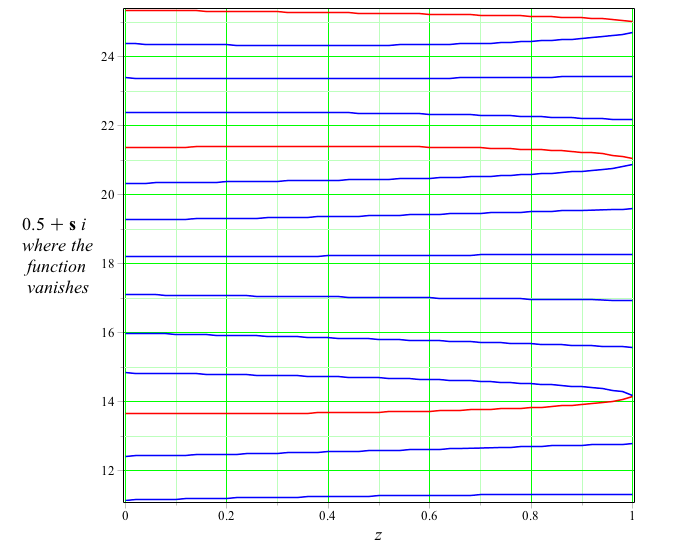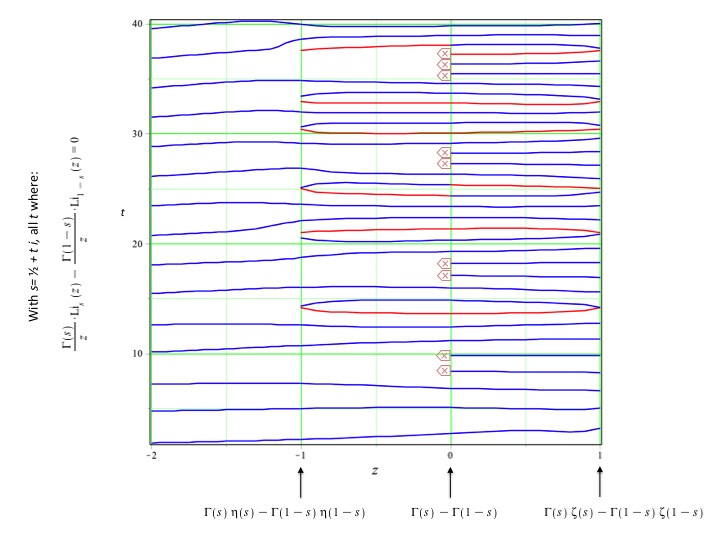Numerical evidence suggests that all complex zeros residing in the critical strip $0 < \Re(s) < 1$ of:
$$\frac{\Gamma(s)}{z}Li_s(z) \, \pm \, \frac{\Gamma(1-s)}{z}Li_{1-s}(z)$$
are on the critical line $\Re(s)=\frac12$ for all $z \lt 1$ (with both individual terms $\ne 0$, except when $z=-1$).
I derived two integral expressions for this function that both only converge in the strip for $z \lt 1$,
$$\displaystyle \int_0^\infty \frac{t^ {s-1} \, \pm \, t^{-s}}{\mathrm{e}^{t}-z}\mathrm{d}t$$
and
$$\displaystyle \int_0^1 \frac{\ln^{s-1}\left(\frac{1}{t}\right) \, \pm \, \ln^{-s}\left(\frac{1}{t}\right)} {1-z\,t}\mathrm{d}t$$
however neither does reveal any further information about their zeros.
Notes:
- when $z \rightarrow 0$, the function reduces to $\Gamma(s) \pm \Gamma(1-s)$, for which it has been proven here that all complex zeros in the strip are on the critical line (and only a finite number lie outside the strip). Additional observation 1: I found that by gradually increasing $z$ from $0$ to $1$ and for each step calculating the 'adjacent' zeros (that I still find to all reside on the line $\Re(s)=\frac12$), their imaginary parts $s$ seem to follow a path connecting a zero of $\Gamma(s) - \Gamma(1-s)$ when $z \rightarrow 0$, uniquely to a zero of the function at $\Gamma(s)\zeta(s) - \Gamma(1-s)\zeta(1-s)$ when $z \rightarrow 1$. The following graph shows these paths with $z$ on the horizontal axis increased by steps of $0.02$ and the imaginary part $s$ at values in $\frac12 + s \,i$ where the function vanishes. The paths that lead to the non-trivial zeros are marked in red. Also tried a similar plot for $z$ decreasing from $0$ to $-1$ and although the paths seem to nicely continue for all non-trivial zeros, I did find that some of the other zeros on the line $z=0$ do not map to zeros on the line $z=-1$ that equals $\Gamma(s)\eta(s) - \Gamma(1-s)\eta(1-s)$.

Additional observation 2: Here is more complete picture of where the function vanishes at imaginary values $t$ when $s=\frac12 + t i$:

The one-to-one connection between the zeros at $z \rightarrow 0$ and $z \rightarrow 1$ appears to be pretty robust, however the connection between $z \rightarrow 0$ and $z \rightarrow -1$ is much more chaotic (although the lines coming from the far left all firmly pass through). Clearly not all zeros of $z=-1$ match with zeros at $z=0$, however it does appear that all lines starting at non-trivial zeros on the $\eta$-line $(z=-1$), do have a path to the $\Gamma$-line $(z=0)$. The lines on the right marked with a little cross actually do run a bit further towards $z=-1$, but never make it to the 'other side'. I also found there do exist zeros lying off the critical line and in the strip around the spot where the path of these lines at $s=\frac12+t i$ strands (e.g. for: $0.1809532919+9.053131045 i$ at $z=-0.82$ or $0.5580702805+36.69087427 i$ when $z=-0.8$).
- unlike for $\Gamma(s)$ and $\zeta(s)$, there doesn't seem to exist a reflection formula relating $Li_s(z)$ and $Li_{1-s}(z)$.
Questions:
- Are there known counter examples of complex zeros lying off the critical line, but still in the strip (I know there do exist a few complex zeros outside the strip and also that there are real zeros)?
EDIT: zeros lying off the line and in the strip have been found in the area between $z=-1$ and $z=0$ (zee above). I therefore like to now restrict the domain of my conjecture to: $0 \le z \lt 1$ and $z \le -1$.
- Is this phenomenon a consequence of the RH or would a prove of it imply the RH (note that $z=-1$ turns the $Li_s(z)$ into the Dirichlet $\eta(s)$-function that can be directly related to $\zeta(s)$)?
Added:
- Could there be a logical reason why the zeros of $\Gamma(s)-\Gamma(1-s)$ $(z \rightarrow 0)$, that have been proven to all reside on the line $\Re(s)=\frac12$, should have a one-to-one path connection with the zeros of $\zeta(s)\Gamma(s) - \zeta(1-s)\Gamma(1-s)$ $(z\rightarrow 1)$?
Thanks.
